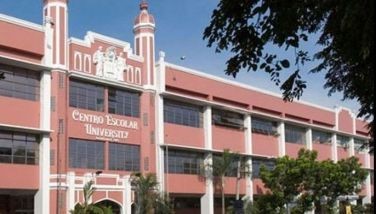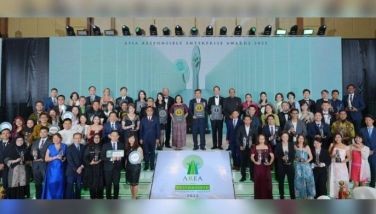A resonant presence
April 15, 2002 | 12:00am
Let me acknowledge receipt of a letter from Mrs. Gloria F. Rodriguez, formerly of New Day and now publisher of Giraffe Books, responding to a recent piece I wrote about National Book Store’s new policy of removing slow-selling literary titles from its shelves.
"Yes, I was aghast when I received several copies of the letter from the NBS asking publishers to pull out their ‘slow-moving books’ within three weeks; otherwise, they would be considered abandoned and would be treated accordingly," Mrs. Rodriguez said. "I am afraid that NBS will only have textbooks and cheap locally published newsprint pocketbooks... left on their shelves, depriving more serious readers of their kind of reading fare. Not even the books of our National Artists for Literature and Palanca awardees would survive the scythe that will cut them out of the NBS shelves. I grieve for our future generations."
Philippine literature has Mrs. Rodriguez to thank for her stewardship of New Day, a small but enterprising publisher of local authors during the martial law years, when not much serious literary publishing was being undertaken otherwise. Her experience and her contributions, among those of others, demonstrate precisely why it is important for some shelf space to be reserved for low-profit or even unprofitable items that serve social needs, i.e., the need to feed and nourish the Filipino imagination.
Companies, like National Book Store, which tower over their competitors in their field, have this social responsibility to meet, like industry-leading corporations and institutions. We can argue that no company should be made to pay for the inefficiency or the failure of another, and it would seem that we are asking NBS to bear the financial burden of small publishers for whom literary publishing is almost invariably a perilous financial proposition.
But NBS is what it is today at least partly because of the patronage of thousands of Filipino readers whose interest in reading begins in our schools, whose mission it is to develop a literary consciousness embracing both "serious" and popular literature. We don’t teach (we don’t have to teach) Tom Clancy or Danielle Steele in our classes, but we develop readers for them by teaching our students to read both foreign and Filipino authors in our literature classes. In other words – so my theory goes – NBS has an audience for bestsellers partly because we help create that audience by teaching non-bestselling works. I think NBS owes it to our teachers and students – and to our writers, of course – to maintain that symbiotic relationship. The store’s owners should acknowledge that every reader of, say, Alfred Yuson is also a potential reader of John Grisham, as different as they may be – and, one hopes, vice versa.
And what a sorry situation it would be if a store that proudly calls itself the national book store should relegate itself to being a merchant of fluffy bestsellers and school supplies. I hope NBS reconsiders its decision and reserves some space, however small, for the best of new Filipino literature.
Last week’s piece on "Things We Haven’t Done in a While" generated a flurry of appreciative (and much-appreciated) responses, among which was this e-mailed message from an old friend and highly-esteemed writer, lately of Dumaguete but now based in Iowa, Rowena Tiempo-Torrevillas:
"Your reminiscence of the summertime delights of childhood, notwithstanding the sting of merthiolate, was a complete delight, Butch. Particularly on a day in the Midwest when springtime seems seems to have made up its mind not to arrive, after a winter that never was.
"I too miss the caimito trees of my childhood. My Dad filled our backyard with fruit trees, in recollection of his own childhood, when one of his boyhood delights was filching sweeter fruits from the fields of Maasin. He thought he’d give his kids all the fruit trees they wanted, sans the lure of petty thievery. So my brother was taught to climb trees before he could even walk (an infant held up by Dad in the lower branches of the avocado and the guava trees, with my mom remonstrating, ‘Ed! Ed!’ I myself fell from one of the mango trees at 10, dislocating and fracturing an elbow; that put paid to my mom’s fond hopes I’d be a ballerina someday.
"I write this in the midst of applying for a ‘Scholar at Risk’ grant for safe haven in Iowa, on behalf of one of our Palestinian poets who’s trapped in Ramallah (though in conscience, he’s not willing to leave his homeland just yet, even if he could). So your column was a healing balm, indeed, in a time of bombs abroad, and my own continual homesickness for Dumaguete.
"Many thanks for bringing me home with ‘Things We Haven’t Done in a While.’"
And thanks to you, Rowena, and to all the others who wrote in with their own remembrances of kaimitos past.
What is it in Graz, Austria that seems to attract paintings by Filipino masters sold on eBay? Last week, another work attributed to H.R. Ocampo was sold from Graz for the final bid of $930. (Let’s recall that last August, a painting attributed to National Artist Fernando Amorsolo was sold on eBay from Graz by another seller for just over $8,100. Some questions were subsequently raised about its authenticity, and the painting – or another one very much like it – surfaced for sale in Manila not too long ago.) If the Ocampo painting – which its Austrian seller (trading under the pseudonym "ebibe") claims to have inherited from an uncle who visited Manila in the ’80s – turns out to be legit, then its buyer ("adarna") would’ve made a killing, even after paying the equivalent of P50,000.
The romantic in me wants to applaud "adarna" for his or her coup; the skeptic wants to go to Graz and uncover a gang of Austrian elves imbibing schnapps while faking one Filipino master after another in a musty cellar, with one of them assigned to peck away on a computer to offer up their latest "masterpiece" on eBay. I swear, if a Manansala or a Magsaysay-Ho turns up on eBay out of Graz the next time I look, I’m going to hock the farm, take the next plane out to Austria, and buy up the city of Graz, famous for its museum of medieval armor and its warehouse of Pinoy masters.
A new book was recently launched at the Filipinas Heritage Gallery that I’d be saying a whole lot more about if I weren’t involved, however marginally as its copy editor, in its production – a handsome and compelling book simply titled Silence, by Randy David and Jaime Zobel, designed by Dopy Doplon.
I have a suspicion that Krip Yuson will do a full-scale review of the book soon (You’re right. See Page L-9 – Editor), so I’ll leave off the best parts for now and simply tell you that the project comprises essays based on interviews with 19 different Filipinos from all walks of life – a film director, a computer whiz, a convict on Death Row, a Mangyan farmer, a bishop, and a pop composer, among others. All were asked by David – a sociologist by training – about their idea of silence and its role in their lives, with Zobel providing the illustrations.
I had the privilege of collaborating with Messrs. Zobel and Doplon on another book a few years ago, called The Island (Ayala Foundation, 1997), and it was an alternately exhilarating and nerve-wracking experience, trying to match talents with two very accomplished and talented professionals. People have asked me since then what it was like to work with someone whom you would have to gulp twice to call "Jaime" without the customary "Don" (and no, we don’t mean as in "Don Johnson"). I can tell you that it was very pleasant and fulfilling, collaborating not with the CEO but the fellow artist; at the same time, you were ever aware that Jaime Zobel was used to getting things done with professional efficiency and thoroughness.
I’m sure that you will find as much pleasure reading Silence as its creators had producing it – a unique book meant for a unique coffee table, about unique Filipinos for whom silence is never just a dull void but a resonant presence.
Send e-mail to Butch Dalisay at penmanila@yahoo.com.
"Yes, I was aghast when I received several copies of the letter from the NBS asking publishers to pull out their ‘slow-moving books’ within three weeks; otherwise, they would be considered abandoned and would be treated accordingly," Mrs. Rodriguez said. "I am afraid that NBS will only have textbooks and cheap locally published newsprint pocketbooks... left on their shelves, depriving more serious readers of their kind of reading fare. Not even the books of our National Artists for Literature and Palanca awardees would survive the scythe that will cut them out of the NBS shelves. I grieve for our future generations."
Philippine literature has Mrs. Rodriguez to thank for her stewardship of New Day, a small but enterprising publisher of local authors during the martial law years, when not much serious literary publishing was being undertaken otherwise. Her experience and her contributions, among those of others, demonstrate precisely why it is important for some shelf space to be reserved for low-profit or even unprofitable items that serve social needs, i.e., the need to feed and nourish the Filipino imagination.
Companies, like National Book Store, which tower over their competitors in their field, have this social responsibility to meet, like industry-leading corporations and institutions. We can argue that no company should be made to pay for the inefficiency or the failure of another, and it would seem that we are asking NBS to bear the financial burden of small publishers for whom literary publishing is almost invariably a perilous financial proposition.
But NBS is what it is today at least partly because of the patronage of thousands of Filipino readers whose interest in reading begins in our schools, whose mission it is to develop a literary consciousness embracing both "serious" and popular literature. We don’t teach (we don’t have to teach) Tom Clancy or Danielle Steele in our classes, but we develop readers for them by teaching our students to read both foreign and Filipino authors in our literature classes. In other words – so my theory goes – NBS has an audience for bestsellers partly because we help create that audience by teaching non-bestselling works. I think NBS owes it to our teachers and students – and to our writers, of course – to maintain that symbiotic relationship. The store’s owners should acknowledge that every reader of, say, Alfred Yuson is also a potential reader of John Grisham, as different as they may be – and, one hopes, vice versa.
And what a sorry situation it would be if a store that proudly calls itself the national book store should relegate itself to being a merchant of fluffy bestsellers and school supplies. I hope NBS reconsiders its decision and reserves some space, however small, for the best of new Filipino literature.
Last week’s piece on "Things We Haven’t Done in a While" generated a flurry of appreciative (and much-appreciated) responses, among which was this e-mailed message from an old friend and highly-esteemed writer, lately of Dumaguete but now based in Iowa, Rowena Tiempo-Torrevillas:
"Your reminiscence of the summertime delights of childhood, notwithstanding the sting of merthiolate, was a complete delight, Butch. Particularly on a day in the Midwest when springtime seems seems to have made up its mind not to arrive, after a winter that never was.
"I too miss the caimito trees of my childhood. My Dad filled our backyard with fruit trees, in recollection of his own childhood, when one of his boyhood delights was filching sweeter fruits from the fields of Maasin. He thought he’d give his kids all the fruit trees they wanted, sans the lure of petty thievery. So my brother was taught to climb trees before he could even walk (an infant held up by Dad in the lower branches of the avocado and the guava trees, with my mom remonstrating, ‘Ed! Ed!’ I myself fell from one of the mango trees at 10, dislocating and fracturing an elbow; that put paid to my mom’s fond hopes I’d be a ballerina someday.
"I write this in the midst of applying for a ‘Scholar at Risk’ grant for safe haven in Iowa, on behalf of one of our Palestinian poets who’s trapped in Ramallah (though in conscience, he’s not willing to leave his homeland just yet, even if he could). So your column was a healing balm, indeed, in a time of bombs abroad, and my own continual homesickness for Dumaguete.
"Many thanks for bringing me home with ‘Things We Haven’t Done in a While.’"
And thanks to you, Rowena, and to all the others who wrote in with their own remembrances of kaimitos past.
What is it in Graz, Austria that seems to attract paintings by Filipino masters sold on eBay? Last week, another work attributed to H.R. Ocampo was sold from Graz for the final bid of $930. (Let’s recall that last August, a painting attributed to National Artist Fernando Amorsolo was sold on eBay from Graz by another seller for just over $8,100. Some questions were subsequently raised about its authenticity, and the painting – or another one very much like it – surfaced for sale in Manila not too long ago.) If the Ocampo painting – which its Austrian seller (trading under the pseudonym "ebibe") claims to have inherited from an uncle who visited Manila in the ’80s – turns out to be legit, then its buyer ("adarna") would’ve made a killing, even after paying the equivalent of P50,000.
The romantic in me wants to applaud "adarna" for his or her coup; the skeptic wants to go to Graz and uncover a gang of Austrian elves imbibing schnapps while faking one Filipino master after another in a musty cellar, with one of them assigned to peck away on a computer to offer up their latest "masterpiece" on eBay. I swear, if a Manansala or a Magsaysay-Ho turns up on eBay out of Graz the next time I look, I’m going to hock the farm, take the next plane out to Austria, and buy up the city of Graz, famous for its museum of medieval armor and its warehouse of Pinoy masters.
A new book was recently launched at the Filipinas Heritage Gallery that I’d be saying a whole lot more about if I weren’t involved, however marginally as its copy editor, in its production – a handsome and compelling book simply titled Silence, by Randy David and Jaime Zobel, designed by Dopy Doplon.
I have a suspicion that Krip Yuson will do a full-scale review of the book soon (You’re right. See Page L-9 – Editor), so I’ll leave off the best parts for now and simply tell you that the project comprises essays based on interviews with 19 different Filipinos from all walks of life – a film director, a computer whiz, a convict on Death Row, a Mangyan farmer, a bishop, and a pop composer, among others. All were asked by David – a sociologist by training – about their idea of silence and its role in their lives, with Zobel providing the illustrations.
I had the privilege of collaborating with Messrs. Zobel and Doplon on another book a few years ago, called The Island (Ayala Foundation, 1997), and it was an alternately exhilarating and nerve-wracking experience, trying to match talents with two very accomplished and talented professionals. People have asked me since then what it was like to work with someone whom you would have to gulp twice to call "Jaime" without the customary "Don" (and no, we don’t mean as in "Don Johnson"). I can tell you that it was very pleasant and fulfilling, collaborating not with the CEO but the fellow artist; at the same time, you were ever aware that Jaime Zobel was used to getting things done with professional efficiency and thoroughness.
I’m sure that you will find as much pleasure reading Silence as its creators had producing it – a unique book meant for a unique coffee table, about unique Filipinos for whom silence is never just a dull void but a resonant presence.
BrandSpace Articles
<
>




















